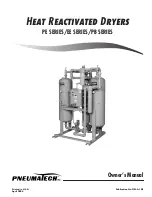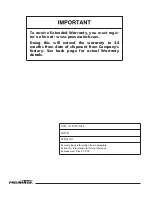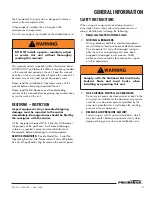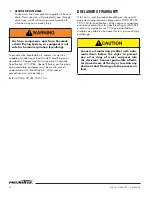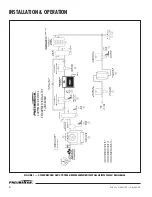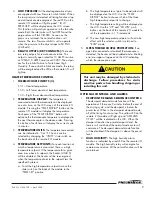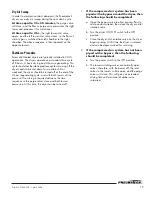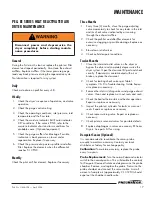
Pub. No. OM-A-10E — April 2004
5
DESICCANT REPLACEMENT PROCEDURES
Pneumatech uses Activated Alumina Grade A desiccant
for all standard heat reactivated air dryers. Dryers up to
1500 SCFM are factory filled with desiccant. Dryers
1800 SCFM and larger are supplied with loose desiccant
in 50 lb. bags. The dryer must be filled with desiccant
before start-up. Dryers ranging from 35 SCFM to 500
SCFM use 1/8" diameter desiccant. Dryers 650 SCFM
and larger use a mix of 1/8” and 1/4" size desiccant.
See the dryer specification sheet or dryer data tag for
amounts per tower.
FILLING PROCEDURE
1.
Make sure the dryer is depressurized.
2.
Remove the plugs or flanges from the fill ports
located on the top of the pressure vessels.
3.
Using a flashlight, inspect the inside of each vessel to
be sure they are empty.
4.
Verify that the desiccant drain port located in the
bottom of the pressure vessel is closed tightly.
5.
Desiccant is available in 50# bags, or 300# barrels.
Divide the desiccant into equal amounts for each
tower, and verify the correct amount by the
specification tag located on the electrical panel.
Towers can be filled manually with desiccant bags.
A fork lift or overhead crane should be used when
filling with 300# barrels.
6.
Dryers 650 SCFM and larger use two sizes of
desiccant. For all heat reactivated models, fill the
tower with the 1/4" diameter Activated Alumina
first
, followed by 1/8" Activated Alumina. The
large desiccant (1/4” size) is used to disperse the
inlet
air flow.
7.
Close the fill ports and put the dryer in service. Refer
to the Start-Up Procedure listed in this manual.
MOLECULAR SIEVE OPTION
(LOW DEWPOINT)
Dryers with optional Molecular Sieve are filled with the
Activated Alumina
first
and the Molecular Sieve
last
. The
Molecular Sieve is used as a polishing agent to lower the
dewpoint temperature.
NOTE:
The proper amount of desiccant may or may not
fill the vessel to the top.
DRAINING PROCEDURE
The desiccant can be removed by the two methods listed
below.
MAKE SURE THE DRYER IS DEPRESSURIZED
PRIOR TO REMOVING THE FILL OR DRAIN PORT.
Method #1 –
Remove the drain port and drain the
desiccant into buckets which are then poured into the
proper dumpster or receptacle.
Method #2 –
Usually used for large dryers (1000 SCFM
and larger). An industrial dry vacuum cleaner is required
for this method.
1.
Remove the desiccant fill port.
2.
Using an industrial vacuum cleaner, remove the
desiccant from the vessel.
3.
Open the desiccant drain port and remove the
remaining desiccant.
DESICCANT DISPOSAL
Desiccant is not considered a hazardous waste, unless
contaminated with oil or other toxic substances. Disposal
of the desiccant should be handled by a local waste
management company.

